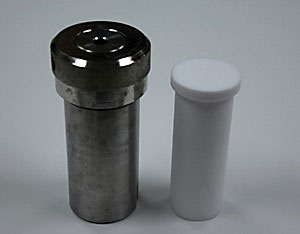| Posted: Oct 27, 2010 |
|
Green chemistry: Going lead-free is easy
|
|
(Nanowerk News) Lead zirconate titanate (PZT) ceramics are high-performance piezoelectric materials that generate a voltage in response to an applied stress, and change shape in response to an applied voltage. They are an integral component of a wide range of electronic devices, including sensors, transformers and loudspeakers. Previous studies have shown that piezoelectric materials display the best piezoelectric performance when their composition is close to a transition region called the morphotropic phase boundary (MPB). In the case of PZT ceramics, the MPB state equates to a composition of 60% lead by weight. However, the production and disposal of materials with such a high lead content pose serious threats to human health and the environment.
|
|
Sodium potassium niobate (NKN) ceramics are a promising lead-free substitute for PZT, having an MPB composition of equal parts sodium and potassium. Unfortunately, the high temperatures required for conventional synthesis of NKN ceramics volatilizes the potassium atoms and can therefore affect the sodium-to-potassium ratio. These processes are also time-consuming and involve many steps, including pre-mixing, ball-milling, calcination and sintering.
|
|
Gregory Goh and Albertus D. Handoko at the A*STAR Institute of Materials Research and Engineering have now demonstrated a hydrothermal process for the synthesis of NKN ceramics ("Hydrothermal synthesis of sodium potassium niobate solid solutions at 200°C ").
|
 |
| Photograph of the stainless steel reactor used for the hydrothermal synthesis of NKN piezoelectric ceramics. The hydrothermal process is simple, fast and consumes much less energy than conventional methods for preparing lead-free piezoelectric materials.
|
|
The hydrothermal method is not only an environmentally friendly, low-cost technique, it is also already widely used to synthesize nanostructured materials. The researchers added niobium pentoxide to an aqueous mixture of potassium and sodium hydroxides and allowed them to react in a pressure cooker at 200 °C for 24 hours. When the reaction ended, they washed the precipitated powders with deionized water and then dried the solids in air.
|
|
X-ray diffraction studies revealed that NKN powders with close to the MPB composition could indeed be obtained hydrothermally, except that the solids were a mix of NKN and sodium niobate. The researchers found that heating the mixed phase at 800 °C for two hours gave a single-phase NKN powder with a composition practically at the MPB. The finding suggests that an atomic exchange process between the potassium and sodium atoms had occurred—similar to that which occurs during calcination in conventional processes.
|
|
"The observation that NKN solid solutions can be synthesized at compositions close to the MPB means that lead-free piezoelectric thin films can also be made by this solution technique," says Goh. "This further extends the potential of this synthesis method, as thin films are essential for miniaturized devices."
|

